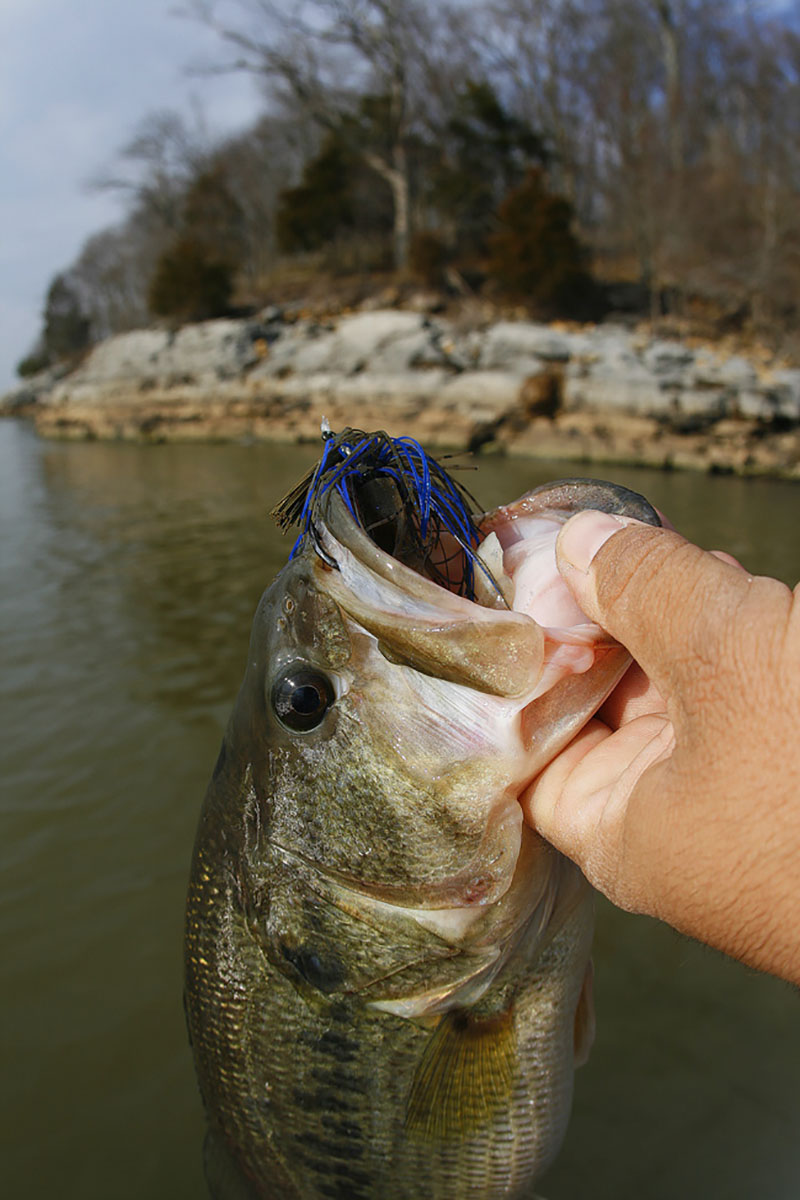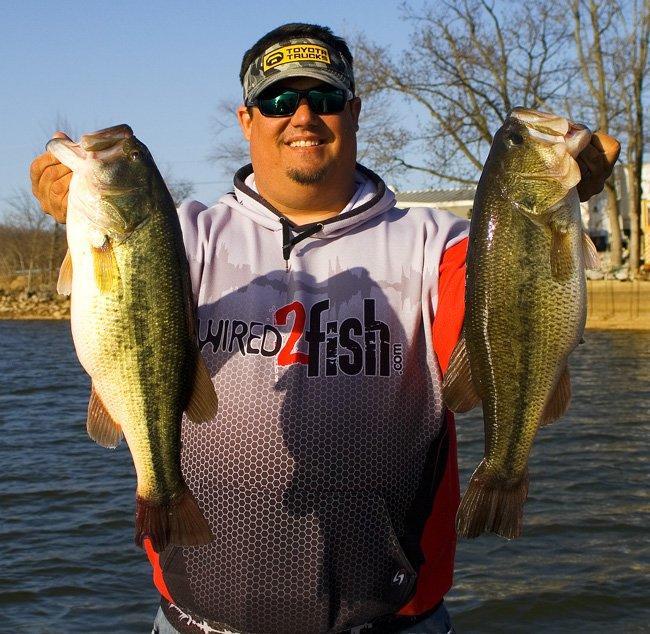For many of our readers, fall is nothing but a distant memory. The trees have shed their foliage and the pleasant, cool nights have quickly turned to bone-chilling mornings with no hope of fishing. As the water temperatures continue to drop and the bass’ metabolism begins to slow, fishing can get downright tough this time of year. It happens to us, too, as we often refer to it as our yearly “depression”.
While many outdoorsmen tend to store their bass boats in favor of tree stands and rutting bucks this time of year, we have salvaged many poor fishing days with the “old faithful” of fishing techniques—the Carolina rig. Although the C-rig has been around for decades, it is one of the most overlooked and misunderstood weapons of the bass fishing world. In part one of this two-part series, we discuss the importance of using quality components with this time-tested technique.
Don’t go cheap
Although many of us choose to make fishing an expensive sport, it really doesn’t have to be. While there are certainly various techniques and presentations in which concessions in quality can be made if necessary, Carolina rigging is definitely not one of them.

Perhaps the most important part of the Carolina rig is the swivel. On that very piece of equipment, the total success of the rig hinges. Poor quality barrel swivels will easily get nicked and cut when dragging the C-rig through harsh terrain such as rocks, shell beds and pea gravel. When these low-end swivels get beat up, they will cut your line like a razorblade and bind, resulting in an improper presentation. To avoid this menacing problem and land more fish, using bigger stainless steel swivels will provide the backbone of your Carolina rig with increased durability and dependability. Although a little more expensive, upgrading swivels can cure some of the heartache from lost Carolina rig fish.
A quality tungsten weight is also essential to getting the most out of your Carolina rig. Many anglers are still unsure when it comes to the benefits of tungsten, but the difference in sensitivity between tungsten and lead is unreal. A tungsten weight on a Carolina rig is about as close as you can get to crawling on your hands and knees on the bottom of the lake. For the anglers who don’t have access to high-end electronics, a tungsten-weighted Carolina rig is all that’s necessary to dissect the bottom composition of your favorite spots. Although they are more expensive than traditional lead weights, the benefits are undeniable which them worth the extra money.

Lastly, you can’t be cheap when it comes to the quality of the hook on a Carolina rig. During the hookset, there is a lot of slack between you and the fish, which makes a razor-sharp hook an absolute necessity. The good news is, hooks aren’t too expensive, and you won’t need a box full of an enormous assortment of hooks in order to increase your success. All that’s needed is 3/0, 4/0 or 5/0 Offset EWG worm hooks. While the versatility of the Carolina rig allows anglers the ability to experiment with several different presentations and pieces of terminal tackle.
Beads
While autumn is largely known for its beautiful colors, crisp mornings and explosive bass fishing, its weather is can be extremely volatile at times. Whether it’s cold fronts, rain storms or premature winter precipitation, fall can be a tricky time of year to consistently catch bass.
Often times, this unstable weather brings about muddy water in fisheries throughout many parts of the country. Although muddy water isn’t widely considered conducive to Carolina rigging, a few small modifications can make all of the difference in the world.

The bead on a Carolina rig is meant to perform two essential tasks—to make noise, while most importantly protecting the knot. If you were to throw a Carolina rig without a bead, the weight would slam against the knot, drastically reducing your knot strength, therefore increasing your chances of losing fish. While many anglers prefer smaller beads in order to offer a more natural presentation to the bass, we tend to prefer larger beads. Larger beads shield the entire knot, giving that crucial connection between your leader and main line a better chance at standing up to more abuse. These beads don’t need to be expensive, either— most of the time your local hobby store sells them for next-to-nothing.
An added benefit of using beads on a Carolina rig is their noise making ability. As you drag the rig across rough surfaces, the bead protects the knot while emitting an awesome “clicking” sound that emulates small prey to bass. It is important to note that different types of beads have different sounds. Although there is no specific science as to when bass prefer different types of clicking sounds, we are big proponents of constant experimentation. If you’re not getting bites with a plastic bead, sometimes a metal bead will do the trick. After experimenting long enough with it, you will be able to notice small nuances of your local fish that will allow for quick and efficient bead changes.
Throughout the late fall and early winter, we have had a lot of success using two beads on our Carolina rigs. As the water gets muddier from nasty fall storms, the visibility of bass is often cut in half. With limited visibility making it harder for bass to get a good bead on your bait, the extra noise of two beads will set your C-rig far apart from others. It would sound a lot better if we had the two beads strategically placed throughout to rig to imitate some sort of specific forage, but we don’t. Stack the two beads right on top of each other for more noise throughout your retrieve. Terry has won a lot of money throughout his life using this technique.
Weights
So we’ve already talked about the importance of tungsten on a Carolina rig, but what now? Truth be told, the shape of the weight doesn’t really make much difference to the bass. Instead, it makes our lives easier and increases our efficiency when throwing the double splash rig all day long.
One of our favorite ways to fish a Carolina rig thick cover looks pretty ridiculous. In fact, if you saw it, you would probably think we were crazy. Around gnarly, rock-covered areas, turning a traditional tungsten bullet weight upside-down—with the nose facing the bait—can drastically cut down on your amount of frustration throughout your day on the water.
When the bullet weight is positioned on the Carolina rig as it would look on a Texas rig, it makes your C-rig much more prone to hang-ups in rocky cover. It is important to remember that the weight is constantly making contact with the bottom, which will cause the nose of the bullet weight to frequently lodge into rocks. If you simply turn that weight the other way around, the wide mouth of weight’s base will kick up off the rock crevices rather than sliding in between them as easily. It doesn’t look pretty, but it can allow for a few less snags.
Unless you’re targeting fish in less than 6-feet of water this late fall, your Carolina rig needs to have a 1/2-ounce weight at the very minimum. The appeal of the Carolina rig is to allow for constant contact with the bottom, and lighter weights don’t allow for the proper presentation. A heavier, 1/2-ounce weight allows the angler to throw it a lot further and detect bites better.
If you’re fishing on a windy day, or are a newcomer to the Carolina rig, throwing a 1-ounce weight can do wonders. The heavy weight decreases the amount of “wind bow” in your line, allowing much more direct access to the business end of your rig. While some anglers will have extremely specific weights for certain water depths, we prefer to keep it simple. Remember—keep a 1/2-ounce tungsten weight on your rig, and if you aren’t feeling the bottom enough, simply upsize to a 1-ounce weight.
It’s no secret that Carolina rigs can be time consuming to re-tie after numerous hang-ups throughout the day, but using the correct components will help you better utilize your fishing time and catch more fish. Stay tuned for part-two of this series, as we discuss the application of different line types and leader lengths to further your success with the C-rig.
















